Don’t Guess, Soil Test
Sep 02, 2019

The most important part of any farmer’s management plan should be a soil test to help determine what nutrients in what amounts should be applied to each field. Not only does a soil test help growers make better economic decisions, it also helps them be more environmentally friendly by helping track soil nutrient levels so as not to apply more nutrients than a soil can hold.
More is not always better when applying fertilizer. In most cases, excessive application will cause other nutrients to be unavailable since soil itself has a negative charge, as do some nutrients such as nitrogen and sulfur. Because these two nutrients are negative and soil is negative, when applied in excess, they can move offsite and usually end up in waterways, causing environmental issues.
Depending on cation exchange capacity (CEC), which has a lot to do with soil texture, different soil types have different nutrient-holding capacities. When considering pulling a soil sample, keep in mind that the more diverse the sample, the more accurate the results. To make sure samples are pulled in all the soil types within a field, go to websoilsurvey.com and put in your address. Then open the soils map to show the various soil types and locations within your field.
Most people follow the soil fertility recommendation on the soil test the first year, then fertilize the following years based on yield removed. After three years, another soil test should be taken to establish a new baseline and make sure all nutrient levels are not dropping below original test levels.
Growers will often ask why nutrient levels have not changed much from their original soil test. The reason for this is the soil fertility recommendations are tied to a yield goal.
If we have had three years of above-average growing seasons and have taken at or near yield that we managed for each year, our soil test will be similar to the original soil sample. Often, soil labs will differ in their recommendations. Some labs have programs tied into where growers should, over time, be increasing nutrient levels within the soil. Other labs will only recommend exactly what is needed to grow a crop.
Recommendations and extraction methods differ among labs, so be consistent. If you used lab A last time, don’t send the new sample to lab B and try to compare.
Soil samples should also be pulled at the same time of year. Soil microbe activity slows in cooler weather, which can have an impact on available nutrients. The best, easiest time to soil sample is usually in the fall as most crops are out of the field.
For more advice about soil testing, contact the agronomy professionals at your local Co-op.
More is not always better when applying fertilizer. In most cases, excessive application will cause other nutrients to be unavailable since soil itself has a negative charge, as do some nutrients such as nitrogen and sulfur. Because these two nutrients are negative and soil is negative, when applied in excess, they can move offsite and usually end up in waterways, causing environmental issues.
Depending on cation exchange capacity (CEC), which has a lot to do with soil texture, different soil types have different nutrient-holding capacities. When considering pulling a soil sample, keep in mind that the more diverse the sample, the more accurate the results. To make sure samples are pulled in all the soil types within a field, go to websoilsurvey.com and put in your address. Then open the soils map to show the various soil types and locations within your field.
Most people follow the soil fertility recommendation on the soil test the first year, then fertilize the following years based on yield removed. After three years, another soil test should be taken to establish a new baseline and make sure all nutrient levels are not dropping below original test levels.
Growers will often ask why nutrient levels have not changed much from their original soil test. The reason for this is the soil fertility recommendations are tied to a yield goal.
If we have had three years of above-average growing seasons and have taken at or near yield that we managed for each year, our soil test will be similar to the original soil sample. Often, soil labs will differ in their recommendations. Some labs have programs tied into where growers should, over time, be increasing nutrient levels within the soil. Other labs will only recommend exactly what is needed to grow a crop.
Recommendations and extraction methods differ among labs, so be consistent. If you used lab A last time, don’t send the new sample to lab B and try to compare.
Soil samples should also be pulled at the same time of year. Soil microbe activity slows in cooler weather, which can have an impact on available nutrients. The best, easiest time to soil sample is usually in the fall as most crops are out of the field.
For more advice about soil testing, contact the agronomy professionals at your local Co-op.